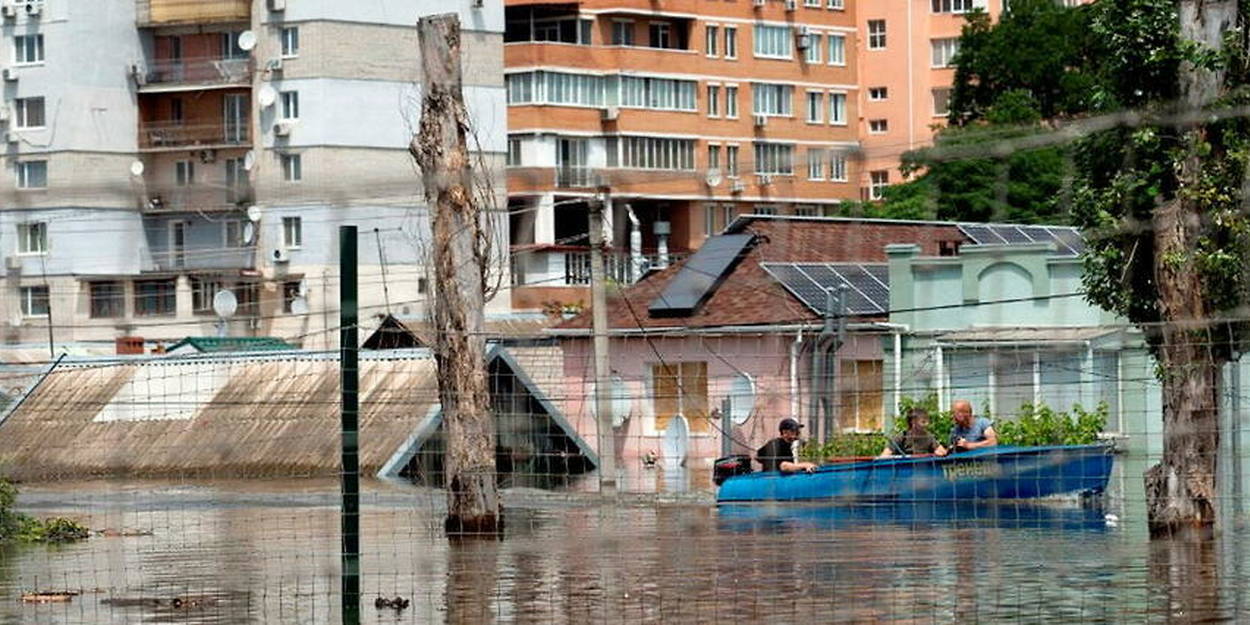MDespite the destruction of the Kakhovka dam on Tuesday, June 6, and the evacuation of civilians in distress, the bombardments continue in Ukraine. On Thursday, the Ukrainian and Russian occupation authorities continue to accuse each other of deadly strikes in the south of the country, targeting civilians, including evacuees from flooded areas after the bombardment of the dam.
At this stage, the two belligerents identify six dead in the floods. Russian occupation authorities in Ukraine accused Kyiv of killing two people, including a 33-year-old pregnant woman, when they bombed an evacuation point in Golan Pristan on Thursday, where Moscow-installed relief workers are helping civilians recover. leave flooded areas. For his part, a Ukrainian army official reported Russian artillery bombardments on the center of the city of Kherson, hit by major floods which left several dead and injured.
As Ukrainian volunteers evacuate civilians in flooded Kherson (without any help from international organizations), the Russians bombard that exact area. pic.twitter.com/7R9lv6S5dx
— inna shevchenko (@femeninna) June 8, 2023
Compensation for victims promised by Zelensky
These bombardments come while Volodymyr Zelensky, the Ukrainian president, was in Kherson on Thursday. During this trip, he provided support to affected civilians and was able to interact with officials and civilians at an evacuation point. “You are going through a difficult ordeal. We will help you and rebuild everything that needs to be […] I would like to thank all the medical staff for their work, even under fire. You are heroic,” he said in a social media post.
The president said he held a “coordination meeting” on “the operational situation in the region” and “the evacuation of the population from potentially flood-prone areas”. He also promised “compensation” for “residents affected by the disaster” and “a program to compensate for losses or relocate businesses to the region”.
20,000 people still without electricity
Since Tuesday, Moscow and kyiv have been rejecting responsibility for the destruction of the dam, located on the Dnieper River, which raises fears of a humanitarian and ecological disaster. Volodymyr Zelensky on Tuesday accused Russia of mining the dam and blowing it up. His Russian counterpart, Vladimir Putin, for his part said on Wednesday that it was “a barbaric act” committed by the Ukrainians. On Thursday, Russia also accused Ukraine before the International Court of Justice (ICJ) of attacking the dam with “massive” artillery strikes.
On the ground, the situation is worrying. Some 600 km2 were flooded in the Kherson region. “32% are on the right bank” of the river, controlled by the Ukrainians, and “68% on the left bank”, occupied by the Russians, detailed Governor Oleksandre Prokoudin.
In two days, 2,198 people were evacuated and many others fled on their own, according to the region’s administration. On the Ukrainian side, “20 localities and 2,629 houses” were flooded, according to the emergency services. A 53-year-old man from the village of Vasylivka, who refused to be evacuated on Wednesday, died, according to Sergey Chaikhet, police chief of the Mykolaiv region.
On the Russian side, 4,500 people “have already been evacuated”, according to the occupation authorities, and “five people […] drowned,” according to Vladimir Leontiev, the mayor of the city of Nova Kakhovka, installed by Russia.
More than 20,000 consumers are still without power, according to Ukraine’s Energy Ministry. The government has launched an appeal for donations for rescuers, in particular for the purchase of boats or motor pumps.
Increase in United Nations aid
In Kherson, 65-year-old Tetiana Omelchenko said she waited for rescuers for two days, eventually crawling out of her apartment through a window to reach the local services rubber dinghy. “In my building, the water has reached the third floor and there are still people there,” she said.
According to an employee of the local meteorological agency, Laura Moussiïane, the water level is 5.33 m above normal. But it “started to go down a bit. If this trend continues, it will be good news for the inhabitants,” she said.
READ ALSOWhat we know about the destruction of the Kakhovka dam in UkraineThe day before, Volodymyr Zelensky had deplored the absence of international humanitarian aid: “The UN, the United Nations and the representatives of the Red Cross are not there”, he denounced, saying he was “shocked”. , in an interview with German media World TV And Picture. “In response to these accusations”, the Red Cross assured to participate in the evacuation operations in Ukrainian territory, with about fifty volunteers.
In a meeting between Ukrainian Foreign Minister Dmytro Kuleba and UN Coordinator in Ukraine Denise Brown, it “was agreed that the United Nations will immediately increase the volume of aid and send forces in Kherson and other affected areas,” the ministry said. French President Emmanuel Macron had announced on Wednesday evening the sending of “aid to meet immediate needs”.
Many worries
Volodymyr Zelensky also said he feared “massive environmental damage”. “We risk losing many species of plants and animals on the red list” of the International Union for Conservation of Nature, said Andriï Yermak, the head of the Ukrainian presidential administration.
Another concern is the Zaporijia nuclear power plant. The level of the dam’s water reservoir can no longer ensure the cooling of the reactors, the dam operator announced on Thursday. The water level, “below the critical threshold of 12.7 meters”, is no longer sufficient to supply “the basins of the Zaporizhia nuclear power plant” for cooling operations, explained the boss of the Ukrainian operator Ukrhydroenergo, Igor Syrota.
A 4-year-old boy, his father and grandfather were also killed in a Russian strike in the eastern Donetsk region, Ukrainian police announced on Telegram, which also reported five others injured , including four children.
The Kremlin warned on Thursday that Monday’s explosion of an ammonia pipeline in Ukraine, essential for exporting fertilizers, could have a “negative impact” on the future of the crucial grain deal for the global food supply.
